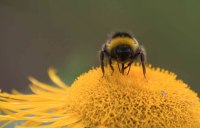Urban beekeeping is coming to Fordham University after the proposal and budget for the project was approved last week by United Student Government (USG).
The USG-funded project will be housed and sustained at St. Rose’s Garden. USG will install the beehive this Wednesday with the bees themselves arriving this weekend.
The idea for the initiative came from sophomore John Kuyat, FCRH ’19, senator for Fordham College Rose Hill, after talking with freshmen who told Kuyat about beekeeping at their high schools.
Kuyat said the Sustainability Committee is taking precautions for students as well.
“We might register with the Department of Public Health with New York,” said Kuyat.
“There is no need to since we are a private institution, but just in order to allay any public concerns the students may have.”
Katherine Sitler-Elbel, FCRH ’18, outgoing vice president of sustainability, said that urban beekeeping will increase the production of vegetation from increased pollination from the bees for the Botanical Gardens and Fordham’s on-campus community garden St. Rose’s.
“To have more bees in urban areas is really important because a lot of times they don’t necessarily have a place where they can set up a hive,” Sitler-Elbel said. “But you provide a place for that [hive].”
She said USG did not factor in economic aspects, adding that the motivation for the project was environmentally driven.
“I think that very little motivation, if any, was for the commercial or advertising effects of it,” said Sitler-Elbel. “Mostly I think that because a lot of our green initiatives that we have are not very well-advertised to begin with. If we really wanted to advertise it and make it known, it would be done, and we don’t do that very much.”
Sitler-Elbel said Fordham’s urban beekeeping initiative is driven by colony collapse disorder (CCD) and the designation of several bee species on the U.S. Fish and Wildlife Service Endangered Species List.
CCD is the rapid loss of adult honey bee population despite the presence of queen bees and food reserves that is not attributed to predator insects, according to the United States Department of Agriculture (USDA).
Although the causes of CCD are unknown, suspected causes for the disappearance of bees are farm pesticides, household herbicides, human development over bee habitat, disease and climate change, according to an article from The Washington Post.
There were nearly 3.5 million honey-producing bee colonies in 1989, according to surveys from the USDA. The number of bee colonies decreased by one million when CCD was first documented in 2006. Since 2006, the bee population has slowly increased through the past decade to over 2.5 million honey-producing bee colonies in 2016.
As of Jan. 1, 2016, honey-producing bee colonies totaled 2.59 million. This is only 8 percent below the 2.82 million colonies on Jan. 1, 2015, according to a report released by the National Agricultural Statistics Service (NASS) and USDA.
However, there is conflicting research on bee colony loss relating to CCD.
The Bee Informed Partnership, an organization in collaboration with the Apiary
Inspectors of America (AIA) and the USDA that conducts annual national survey of honey bee colony losses, found that 28.1 percent of the honey-producing bee colonies were lost in the 2015-2016 winter in the United States.
Conflicting research also found that decrease in bee populations are due to season die-offs. In a 2012 working paper by agricultural economists Randal Tucker and Walter Thurman, it was reported that beekeepers would have typically lost 14 percent of their colonies a year before colony collapse disorder, according to an article by The Washington Post.
Despite these conflicts, the number of honey-producing bees still has not reached the 1989 number of 3.5 million. As of 2016, the number of bees was 2.59 million, still about 1 million below the highest numbers of honey-producing bees.
Urban beekeeping on campus marks a new addition in a series of sustainable initiatives on campus. In 2010, Fordham University received a grant to implement solar panels on the roof of Walsh Library. There is a petition currently circulating to expand the roof solar panels. In February 2017, St. Rose’s Garden added composting projects.
Sitler-Elbel said that past sustainable projects are different from the beekeeping project on campus. “I think a lot of the focus of our sustainable initiatives has been like our recycling program and sort of more educational programs,” Sitler-Elbel added. “But I think the bees really bring in a new aspect to our sustainable initiatives.”
Conor Gilligan, FCRH ’18, who is one of the leaders of the initiative, said that Fordham is not implementing enough projects to address sustainability on campus.
“Although Fordham is a great school, I do not think currently the administration is doing a great job with issues of sustainability. I think some issues we can improve upon is food waste management, so recycling of scrapes and composting for the dormitories,” said Gilligan.
Gilligan added, “Although we have been putting more bins around campus, not many people do recycle. However, the Sustainability Committee is working towards goals and I think we can make some serious improvements in the coming years.”
However, Gilligan also said that he sees the sustainable initiatives like beekeeping are in line with social justice values at Fordham.
“I think Fordham is committed to their Jesuit values and having a beehive on campus will really facilitate learning about nature and we can extend our services to the wider community.”





